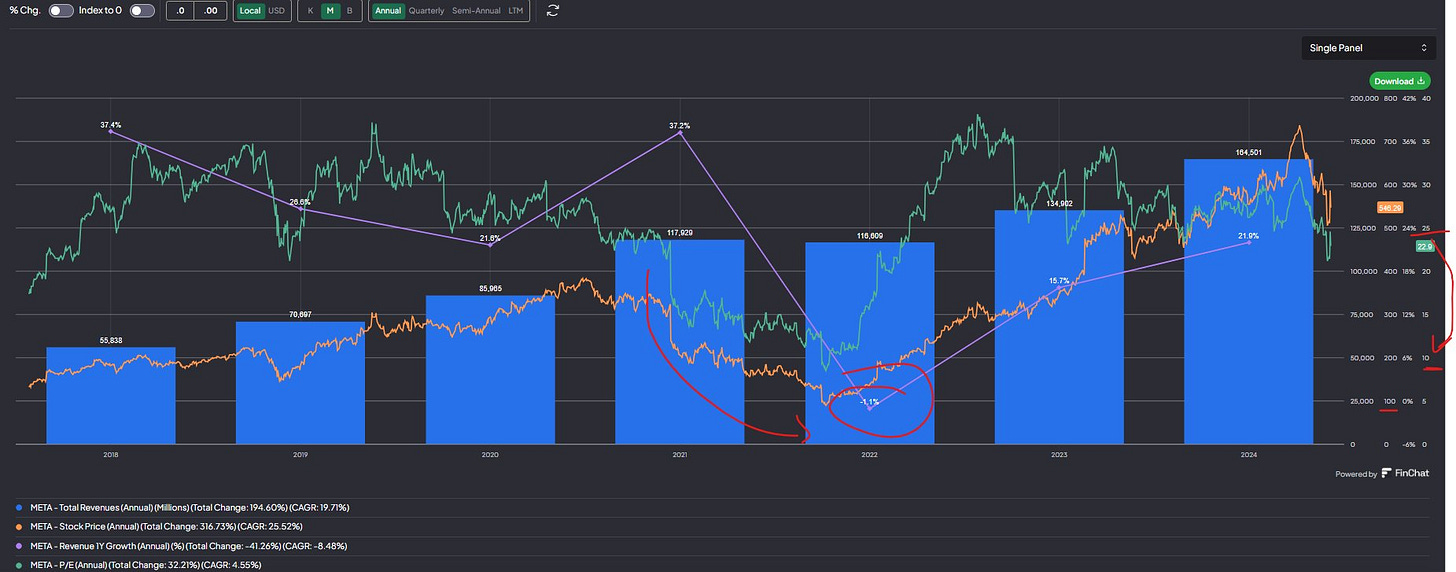Multiple as a Driver of Returns
I am obsessed about finding great investments. When analyzing an investment, there are 3 drivers of return:
Multiple
Growth
Free Cash Flow
I am focusing on why multiple can be the difference between good (10%) and stellar (>30%) returns.
Multiple expansion/compression
The return from this driver is usually limited. For example, let's assume you buy a business for 10x Enterprise Value/Free Cash Flow and, for simplicity, let's assume there is no net debt, so Enterprise Value = Market Cap. This can go two ways in terms of multiple: it can expand (go to 20x) or contract (go to 5x).
If you have a multiple expansion from 10x to 20x, since you have the same denominator (Free Cash Flow), then your investment just grew by 2x. It works exactly the same the other way around; if multiple contracts from 10x to 5x, then your investment was just slashed to 0.5x. The reason the return from multiple expansion is limited is that multiple cannot "expand forever". Take a look at the graph of the historical P/E of Nominal S&P. Ignoring outliers the P/E multiple usually moves around 10x and 25x. So, even if you buy a business at a very cheap multiple (5x P/E), it should max out expansion at 25x, growing your original investment by 5x. Of course, there are exceptions to this. However, historically multiples will tend to go back to a mean and don't have "perpetual growth". Quantitative easing and loose monetary policies change the rules on this, but I don't want to get into that topic right now.
What is the driver of multiple expansion/contraction?
Expectations.
An expanding business has embedded expectations of strong growth, so it carries a high multiple. Let's assume the business was growing 25% Year on Year. Suddenly, the business delivers a weak quarter and you get repricing. This is the very reason buying a good business is not enough to get good returns. A great example are the Nifty Fifty, which was a term to refer to the best 50, large business of the NYSE during the 1960s and 1970s. Some of the businesses from Nifty Fifty are still great businesses today, such as KO 0.00%↑ Coca-Cola. Back then, it was deemed that for such great businesses price was not an issue, with P/E reaching >40x in its peak, more than double of the market by early 1970s. Then, the bear market of 1973-1974 came and the market declines roughly 30-40%, but the Nifty Fifty declined much more (>60%) given the initial high multiples. If you held to these stocks, even entering at the all time highs, by the 1990s you will still have had a roughly similar performance vs. the market, signling the strength of the businesses themselves. However, you would not have beaten the market by blindly choosing great businesses. Valuation matters. Check "Revisiting the Nifty Fifty" from Jeremy Siegel if you are interested in more about this story!
Back to multiple and expectations. A great example of how expectations change is META 0.00%↑ during 2022. The business was growing revenues by 20-30% and in 2022 META 0.00%↑ had a contraction of -1%. Stock price moved from >$300 to $100 and P/E moved from 24x to 10x. The story went from META 0.00%↑ being the powerhouse of social networks and having a great ad business, to META 0.00%↑ ads business being doomed because of Apple iOS restrictions and new social networks (TikTok) gaining share in younger audiences. A growing and blooming business is valued very differently from a decaying business. If you bought META 0.00%↑ at $360 during Sep/21, today you would have 12% annual return. If you invested in VOO 0.00%↑ (S&P 500) instead the return would have been 6%. However, if you bought META 0.00%↑ at $100 during Oct/22, today you would have achieved 96% annual return (compared to 11% of investing in VOO 0.00%↑). Even buying around $230 during April 2022 will have served 33% annual return to date. META 0.00%↑ is a great business, so if you invested 4-5 years ago would have done fine at pretty much any valuation. Since 2020, revenues and operating income almost doubled (in 4 years!). However, the difference between stellar returns and good returns is the entry valuation. Valuation matters!
Meta
I know someone might be asking right now: "well, but how do I know META 0.00%↑ isn't a value trap in 2022?" Eventually I will discuss more on that on points 2 (Growth) and 3 (Free Cash Flow Margin), but that's the whole point of investing! A more recent case of afallout is NKE 0.00%↑. Nike had a multiple of 44x P/E and >$170 share price at its peak and declined to 23x P/E and $70s due to stagnant/declining revenues during 2024. Currently it trades around 18x P/E and $50s with tariffs being the culprit. However, different from META 0.00%↑ I believe right now NKE 0.00%↑ is a value trap. I don't think it is a dying business, but, ignoring tariffs noise (which is another headwind), I don't think there is a scenario where NKE 0.00%↑ should be priced above a 20x P/E. I am not getting into the details of why on this thread, but time will give the veredict!
Nike
Conclusion
Mutiple is a driver of valuation and can be the difference between good and stellar returns. Mutiples are mainly driven by expectations. Expectations are driven by the underlying performance of the business (growth and free cash flow margin). More on that later!





